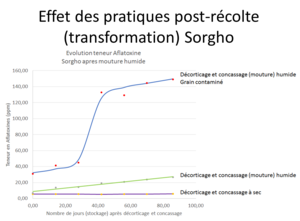Aflatoxins in Haiti


Aflatoxins in Haïti
In Haïti, peanut (called "Pistach"in Haitian Creole) is a crop with great commercial value and the existence of a strong local market. Peanuts are often processed into peanut butter which is rich in proteins and it is often served for breakfast. Despite its commercial and nutritional importance, the peanut value chain is not structured. This partly explains the limited data on aflatoxins contamination of peanut in the country. In a survey of 109 peanut farmers conducted in North and North-East departments of Haiti in 2015, only 23% of the farmers were aware of the existence of aflatoxins.
Other studies have detected higher aflatoxins levels in the peanut butter samples available on the informal market than the recommended standard level (See Figure). Aflatoxins exposure from residents of Haiti was also demonstrated by the detection of aflatoxins linked to blood albumin and the metabolite of aflatoxin B1 in urine samples (Schwartzbord et al., 2014). Peanut butter sold in the informal market is often contaminated because of inadequate sorting and reintroduction of damaged grains into the butter.
Several initiatives to control aflatoxins contamination of peanut have been implemented by some actors involved in the peanut value chain in Haiti. For example Acceso, iF Foundation, MFK and Zanmi Agrikòl have extension services programs to encourage farmers to adapt good practices. These organizations are also monitoring aflatoxins contamination levels in harvested and dried peanut.
Cereals can also be contaminated with aflatoxins. A research study conducted by Chibas in Haiti shows that sorghum can be contaminated in mills during the processing. In Haiti, mills are used for both corn and sorghum, but corn can have high aflatoxins content because of post-harvest practices. The inadequate cleaning process of the mills can cause cross-contamination of sorghum which is processed in the same mills (See Figure)
Reference
Schwartzbord, J., et al., 2014. Aflatoxin-lysine adducts in Haitian patients ingesting peanut and maize products. J. Hunger Environ. Nutr., 9:244-255.

